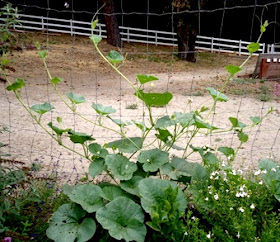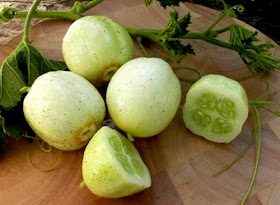We get many questions from gardeners about members of the cucurbit family, so our expert Garden Advisor, Beth Benjamin, has summarized her advice for successfully growing these mainstay garden vegetables. I am very pleased to add Beth’s knowledgeable and experienced voice to our blog.
 |
| Seedlings growing under a berry basket |
 |
| Gourd seedlings sown 3 weeks before last frost |
 |
| Ornamental Gourds |
When planting cucurbit seeds directly outdoors, it’s wise to cover them with netting or plastic berry baskets to keep birds or other critters from eating the seeds before you even see them.
If your growing season is very short or you have problems starting seeds outdoors (or if you are just eager) you can start cucumbers and squashes in individual pots and transplant them when it’s warm enough. They are fast growing seedlings, though, and will suffer if they get too crowded, so don’t sow them any earlier than 3 weeks before you expect to transplant them outside. (Remember that if they are grown too long in the pots, they’ll be so slow to recover from the move that you won’t have saved any time.)
Note: Unless you have a very long growing season, gourds do need to be started ahead as the fruit takes a very long time to mature. Most climates get cold weather too soon to allow enough time if the gourd seeds are sown directly.
Be careful when you are transplanting cucurbit seedlings. Don’t leave them in the containers too long to become root bound and stunted. The soil should be moist (but not soggy) in both the pots the seedlings are coming out of AND the ground they are going into. That way the roots will loosen up and lower nicely into the hole. Take care not to damage the roots, and plant them at the end of the day when they can rest after transplanting in the cool of the evening.
 |
| Seedlings growing in a mound |
If it is more important to have good drainage, make a flat raised mound (only a couple of inches high).
Plant 2 or 3 plants in each circle. If you are planting the seeds directly into the garden, plant 5 or 6 and thin them out, leaving only the 3 best seedlings to grow to maturity. Properly thinned plants will be healthy and won’t need to compete for nutrients and light, so you’ll get much better results.
 |
| Vining squash growing in a bed |
Trellising: In a small space garden it’s a good idea to grow cucumbers up a trellis or fence. Growing the vines up also protects fruits from damage or disease from lying on moist ground. Gravity helps long cucumbers grow straighter as they are hanging down.
 |
| Gourds growing on a fence |
 |
| Gourds growing on a metal arbor |
Pollination: I get a lot of questions from gardeners concerned that they are getting flowers but no fruit.
 |
| Male & female squash flowers |
 |
| Hand-pollinating squash blossoms |
If there are no flying insects to do the pollination, you can hand-pollinate in the early morning after the dew has dried but before it gets too hot, either by picking off the male flower and kissing the female flower with it, or by using a small watercolor type paintbrush and dabbing pollen from male to female flower.

Harvesting: It is important to harvest cucumbers, especially lemon and Armenian, before they get too big and mature. Lemon cucumbers should be a very pale yellow – when they get fully yellow colored, they are overripe and usually seedy with tough skins. If your cucumbers are bitter, it is probably because they didn’t get enough consistent watering. They need to be watered regularly; if you put your finger in the soil and it is dry beyond the first joint, the plants need water. If the fruits are misshapen, they probably didn’t get fertilized well, or are stressed from not enough water.

 Summer squash like zucchini and patty pan can be picked when quite young, even before the flowers fall off, but I think the taste is best and yield is better when zucchinis are no more than 5 or 6 inches, and scallops about 3 inches. While you can pick them a little bigger, it’s important not to let them get so big that seeds develop and rinds are tough because both taste and texture will really suffer. If you check every day or two, you will rarely be trying to give away baseball bat size zucchinis. Now and again you miss picking one and you’ll have a giant to stuff or make into zucchini bread.
Summer squash like zucchini and patty pan can be picked when quite young, even before the flowers fall off, but I think the taste is best and yield is better when zucchinis are no more than 5 or 6 inches, and scallops about 3 inches. While you can pick them a little bigger, it’s important not to let them get so big that seeds develop and rinds are tough because both taste and texture will really suffer. If you check every day or two, you will rarely be trying to give away baseball bat size zucchinis. Now and again you miss picking one and you’ll have a giant to stuff or make into zucchini bread. Hard-shelled winter squash is ready to pick when the stems are hard and the rind can’t be pierced with a thumbnail. They continue to get sweeter if they are left on the vine as long as possible, though. Before heavy frost, cut the stems about an inch above the fruit, and let them mature in the sun for 7-10 days to harden and toughen the skin. Then store in a cool dry place with good air circulation.
Do Make A Second Planting: Except in the very short season areas, it is really worth making a second planting of summer squash and cucumbers, both for salad and for pickles, in early to late June. These heat lovers grow so quickly with seed sown directly into warm summer soil and begin to ripen fruits around just six weeks! Why waste your precious garden space on old, declining squash plants, when you can plant new ones and have continuing delicious harvests to enjoy throughout the season.


it's the bug control I'm interested in. The soft stem squash are a problem for me. What really keeps them alive? I've gone to the burpee's test garden where they put or do nothing to the squash and the bugs win. Does wrapping the stems in foil stop the bugs?
ReplyDeleteThank-you so much for all the helpful information. I have not been having too much success but now I know why. Just get to eager to get them started and the soil is not warm enough. After reading all that you shared I am very keen to try again.
ReplyDeleteIf it is more important to have good drainage, make a flat raised mound (only a couple of inches high).
ReplyDeleteHomegrown organic vegetables are not just good for your yard, they are good for you and your family.
ReplyDeleteWow what a nice post i am so inspired here could you more share here i will be back to you as soon as possible.
ReplyDeleteThanks for sharing...
garden centre Luton
Anonymous: Squash borers are a real problem in part of the country.
ReplyDeleteBest solution is to put floating row covers over the plants, taking them off just in time to be pollinated.
Turtlegarden: Thanks for writing, this spring especially many people started too early, so it's a common mistake everyone's made.
ReplyDeleteAtlantic Homecare: Good point. Thanks for writing
ReplyDeleteGardenCentre: Glad to hear from you. Check back often for more articles, and look at our website where there are a lot more you may find helpful. www.reneesgarden.com
ReplyDeleteI am getting lots of blooms but no zucchini . I am wondering if it is a pollination issue. I do have bees in the area and my neighbors are bringing me their squashes.
ReplyDeleteHi Renee,
ReplyDeleteI just read this post from your advice in the SUPER FAST email response you gave me!
I'm in Thailand, will the kirbies grow in this weather?